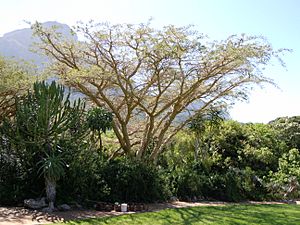Paperbark acacia facts for kids
Quick facts for kids Paperbark acacia |
|
|---|---|
 |
|
| In Kirstenbosch, Cape Town | |
| Scientific classification | |
| Genus: |
Vachellia
|
| Species: |
sieberiana
|
| Varieties | |
|
|
| Synonyms | |
|
|
The Vachellia sieberiana, also known as the paperbark thorn or paperbark acacia, is a fascinating tree. It used to be called Acacia sieberiana. This tree grows naturally in southern Africa. It has also been brought to Pakistan.
Paperbark acacia trees can be quite tall. They grow from 3 to 25 meters high. Their trunks can be wide, from 0.6 to 1.8 meters across. This tree is not in danger of disappearing.
Contents
About the Paperbark Acacia
The paperbark acacia is a very useful tree. People use it for food, medicine, and wood. The inner bark gives strong fibers. These fibers can be used to make things like string for beads.
The tree also produces a special gum. This gum is safe to eat. Many animals, like livestock and wild game animals, eat parts of the tree. They especially like the pods that fall to the ground. When animals eat the pods, they help spread the tree's seeds.
The flowers of the paperbark acacia are great for bees. Beekeepers often place beehives near these trees. This helps the bees collect nectar and make honey.
Sometimes, if animals eat too many leaves, the tree can release chemicals. Some of these chemicals can be harmful to cattle if eaten in large amounts. However, the fallen pods and leaves are very important. They provide food for animals during dry seasons.
The gum from the tree has many uses. People use it as food and as a glue. It can even be an ingredient in making ink.
What the Tree is Used For
Traditional Medicine
In Africa, people use parts of the paperbark acacia for traditional medicine. The bark or root can help with urinary tract problems. The bark is also used for colds, coughs, and childhood fever.
The roots can be made into a special drink. This drink is used to help with stomach aches. The bark, leaves, and gum are also used. They help treat different health issues. These include tapeworms, bilharzia, and problems with bleeding. They are also used for colds, diarrhea, and kidney problems.
Helping the Soil
The paperbark acacia is a type of legume. Like many legumes, it has tiny helpers in its roots. These helpers are called Rhizobium bacteria. These bacteria are amazing because they can take nitrogen gas from the air. They change it into a form that plants can use.
This means the tree does not need extra nitrogen fertilizer. It also helps the plants around it. The soil gets more nitrogen, which is good for all plants. This makes Vachellia trees very important for the environment.
Strong Wood
The wood from the paperbark acacia is quite strong. It is used to make furniture. People also use it for handles on tools. For example, it can be used for tools that grind grain by hand. The wood is also quite dense, weighing about 655 kilograms per cubic meter.
Where it Grows and How it's Protected
The paperbark acacia tree is found in many places where it naturally grows. It is not considered an endangered species. Many animals, like elephants and giraffes, eat its leaves and branches.
Gallery
-
Original description by de Candolle (1825)
See also
 In Spanish: Acacia sieberiana para niños
In Spanish: Acacia sieberiana para niños




